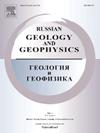Magnetovariational Sounding in South Vietnam according to the Dalat Observatory Data
IF 1
4区 地球科学
Q3 GEOSCIENCES, MULTIDISCIPLINARY
引用次数: 0
Abstract
––This paper describes a three-dimensional inversion of magnetovariational tippers calculated for the Dalat observatory in South Vietnam on the basis of the geomagnetic variation records obtained from the INTERMAGNET network. The frequency dependences of the tippers are inverted using the ModEM software, which makes it possible to construct a geoelectric model of the Dalat zone in a 300 × 300 × 150-km spatial region (x, y, and z axes, respectively) with its center located at the observatory. The resulting model of the geoelectric section contains both surface and deep conductive blocks located at the top and bottom of the Earth’s crust and in the upper mantle. The central part of the upper local conducting block with a resistivity of 0.5–1.0 Ohm⋅m is located near the observatory at a depth of 12–14 km. A more massive conductive block is located to the east of the observatory in the coastal region. Its central part with a resistivity of 0.3 Ohm⋅m is located at a depth of 24–28 km and extends under the continent along the coast for about 80 km. The roots of this block are visible to depths of ~100 km in the South China Sea shelf region. It is assumed that the high electrical conductivity of these blocks is provided by melting in the presence of aqueous fluids and granite series rocks, which are widely distributed in the Dalat zone. The crystallization depths of the samples of these granites estimated from the geothermobarometry data are close to the depth intervals of conductive blocks in the model section, which was also observed in the interpretation of magnetotelluric soundings in Southern Tibet, where granitoid rocks are widespread.根据大叻天文台资料的南越磁变探测
–本文描述了根据INTERMAGNET网络获得的地磁变化记录,为南越大叻天文台计算的磁变分倾斜度的三维反演。使用ModEM软件反演了倾翻器的频率依赖性,这使得在300×300×150km的空间区域(分别为x、y和z轴)中构建Dalat带的地电模型成为可能,其中心位于天文台。地电剖面的最终模型包括位于地壳顶部和底部以及上地幔中的表面和深层导电块。电阻率为0.5–1.0欧姆·m的上部局部导电块的中心部分位于天文台附近,深度为12–14公里。一个更大的导电块位于天文台东部沿海地区。它的中心部分电阻率为0.3欧姆·米,深度为24-28公里,沿海岸延伸至大陆下方约80公里。在南海陆架区域约100公里深处可以看到该地块的根部。据推测,这些块体的高导电性是通过在水性流体和花岗岩系岩石存在的情况下熔融提供的,这些岩石广泛分布在Dalat带。根据地热测量数据估计的这些花岗岩样品的结晶深度接近模型剖面中导电块的深度间隔,这在解释西藏南部的大地电磁测深中也得到了观察,那里的花岗岩分布广泛。
本文章由计算机程序翻译,如有差异,请以英文原文为准。
求助全文
约1分钟内获得全文
求助全文
来源期刊

Russian Geology and Geophysics
地学-地球科学综合
CiteScore
2.00
自引率
18.20%
发文量
95
审稿时长
4-8 weeks
期刊介绍:
The journal publishes original reports of theoretical and methodological nature in the fields of geology, geophysics, and geochemistry, which contain data on composition and structure of the Earth''s crust and mantle, describes processes of formation and general regularities of commercial mineral occurrences, investigations on development and application of geological-geophysical methods for their revealing. As to works of regional nature, accelerated publication are available for original papers on a variety of problems of comparative geology taking into account specific character of Siberia, adjacent Asian countries and water areas. The journal will also publish reviews, critical articles, chronicle of the most important scientific events, and advertisements.
 求助内容:
求助内容: 应助结果提醒方式:
应助结果提醒方式:


